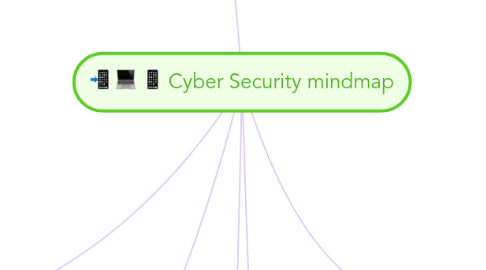Cyber Security mindmap
von Ghani Ghani


1. 1. Introduction
1.1. Cybersecurity refers to the practice of protecting internet-connected systems, including hardware, software, and data, from attack, damage, or unauthorized access.
1.2. This can include measures to prevent and detect hacking, viruses, and other types of cyber attacks, as well as policies and procedures for maintaining the security and integrity of sensitive information. Cybersecurity is a growing concern as more and more of our personal and professional lives take place online.
2. 2.Types of Cyber Attacks
2.1. A cyber attack is an attempt by a hacker or group of hackers to damage or disrupt a computer network or system. These attacks can take many forms, including malware, phishing scams, and denial of service (DoS) attacks. The goal of a cyber attack may be to steal sensitive information, disrupt operations, or cause financial damage. It is important for individuals and organizations to implement strong security measures to protect against cyber attacks.
3. 3.Motives behind Cyber Attacks
3.1. Cyber attacks can have a variety of motives, including financial gain, political or ideological reasons, espionage, and hacktivism. Financial gain can be achieved through methods such as ransomware, where attackers demand payment in exchange for restoring access to a victim's data, or through the theft of sensitive information that can be sold on the black market. Political or ideological motives can be behind attacks aimed at disrupting or influencing a specific organization or government.
4. 4.Need for Cyber Security
4.1. Cybersecurity is important because it helps protect sensitive information, networks, and systems from unauthorized access, use, disclosure, disruption, modification, or destruction. As more and more of our daily lives and important processes rely on the internet and technology, the risk of cyber attacks has increased. These attacks can result in significant financial losses, reputational damage, and even physical harm.
4.2. Additionally, the increasing number and sophistication of cyber threats makes it essential for individuals and organizations to take steps to secure their systems and protect against potential breaches. This includes implementing strong passwords and authentication methods, regularly updating software, and using anti-virus and anti-malware tools. Additionally, organizations should have incident response plans in place to quickly and effectively respond to a cyber attack.
5. 6.Way Forward
5.1. In the context of cybersecurity, "the way forward" may refer to the strategies and tactics that organizations and individuals can use to protect themselves from cyber threats and attacks. Some key elements of a cybersecurity "way forward" may include:
5.1.1. Implementing strong security measures and technologies to protect networks, systems, and data from unauthorized access and malware.
5.1.2. Developing incident response and recovery plans to quickly and effectively respond to security breaches and minimize damage.
5.1.3. Providing regular security training and awareness for employees and other users to help them identify and avoid cyber threats.
